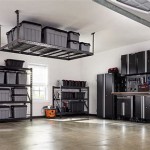How to Hang Ladders in Garage for Optimal Storage
Maximizing space within a garage often requires creative storage solutions, and ladders, due to their size and shape, can present a significant challenge. Efficiently hanging ladders not only frees up valuable floor space but also protects the ladder from damage and potential tripping hazards. This article details various methods for securely and effectively hanging ladders in a garage environment.
Before commencing any installation, a comprehensive evaluation of the garage's structural integrity is essential. Walls must be capable of supporting the weight of the ladder, and the chosen hanging hardware must be appropriate for the wall material (e.g., drywall, concrete, or wood studs). Safety precautions, including wearing appropriate eye protection and gloves, should be observed throughout the entire process.
Selecting the Appropriate Hanging Method
Several methods exist for hanging ladders in a garage, each offering unique advantages and disadvantages. The optimal method depends on the type of ladder, the available space, and personal preferences regarding aesthetics and ease of access.
Horizontal Wall Mounting: This method involves attaching the ladder horizontally to the wall using hooks or brackets. It is generally suitable for lighter ladders, such as step ladders or small extension ladders. Horizontal mounting is relatively simple to implement and provides easy access to the ladder. However, it requires a significant amount of wall space.
Vertical Wall Mounting: Vertical mounting entails suspending the ladder vertically against the wall. This approach is beneficial for long extension ladders, as it utilizes vertical space efficiently. Specialized ladder hooks or brackets designed for vertical mounting are necessary to ensure stability and prevent the ladder from falling. Careful consideration must be given to the ladder's height and the available ceiling clearance.
Ceiling Mounting: Hanging the ladder from the ceiling is an effective option when wall space is limited. This method typically involves using pulleys or heavy-duty straps to lift and secure the ladder to the ceiling. Ceiling mounting requires a robust ceiling structure capable of supporting the ladder's weight. Additionally, sufficient headroom is essential to avoid accidental collisions with the suspended ladder.
Ladder Racks and Shelving Units: Dedicated ladder racks and shelving units offer a structured and organized solution for storing ladders. These systems often incorporate multiple shelves or compartments for storing other tools and equipment alongside the ladder. Ladder racks provide enhanced stability and prevent the ladder from shifting or falling. They are particularly suitable for garages with multiple ladders or a desire for comprehensive storage organization.
The selection process should also include consideration of material and construction. Hooks, brackets, and racks are available in various materials, including steel, aluminum, and plastic. Steel is typically the strongest and most durable option, while aluminum offers a lightweight alternative. Plastic options may be suitable for lighter ladders but should be chosen with caution, ensuring that the weight capacity is sufficient.
Installation Procedures for Wall-Mounted Ladders
The following outlines the general procedure for installing wall-mounted ladder hooks or brackets, applicable to both horizontal and vertical mounting:
Step 1: Mark the Mounting Locations: Using a stud finder, locate wall studs to ensure secure attachment. Mark the desired locations for the hooks or brackets, considering the ladder's dimensions and the spacing between its rungs or side rails. For horizontal mounting, ensure the marks are level to prevent the ladder from tilting. For vertical mounting, confirm that the ladder will not obstruct doorways or other fixtures.
Step 2: Pre-Drill Pilot Holes: Drill pilot holes at the marked locations to facilitate screw insertion and prevent the wood from splitting. The pilot hole diameter should be slightly smaller than the screw diameter.
Step 3: Attach the Hooks or Brackets: Align the hooks or brackets with the pilot holes and secure them to the wall using appropriate screws. Ensure the screws are long enough to penetrate deeply into the wall studs. If mounting to concrete or masonry, use appropriate anchors and screws designed for those materials.
Step 4: Test the Stability: Before hanging the ladder, test the stability of the installed hooks or brackets by applying pressure to them. Verify that they are securely attached and do not wobble or loosen. Reinforce the attachment if necessary.
Step 5: Hang the Ladder: Carefully lift the ladder and position it onto the hooks or brackets. Ensure the ladder is evenly supported and does not put undue stress on any individual hook or bracket.
Specific Considerations for Horizontal Mounting: When mounting a ladder horizontally, ensure that the hooks or brackets are spaced appropriately to support the ladder's weight evenly. Consider using more hooks or brackets for longer or heavier ladders. When possible, orient the ladder so that the wider side rests against the wall to maximize stability.
Specific Considerations for Vertical Mounting: Vertical mounting often requires specialized ladder hooks that feature a curved design to securely grip the ladder's rungs or side rails. Ensure the hooks are rated for the ladder's weight and that they are positioned to prevent the ladder from swinging or swaying. It may be necessary to use additional straps or fasteners to secure the ladder at multiple points along its length.
Installation Procedures for Ceiling-Mounted Ladders and Racks
Ceiling mounting presents additional challenges due to the need to lift and secure the ladder overhead. The procedure typically involves the following steps:
Step 1: Assess the Ceiling Structure: Carefully examine the ceiling structure to identify joists or beams that can support the ladder's weight. Use a stud finder to locate the joists and ensure they are adequately spaced for the ladder's dimensions. If the ceiling is finished with drywall, it may be necessary to remove a section of drywall to expose the underlying joists for reinforcement.
Step 2: Install Mounting Hardware: Attach the mounting hardware, such as pulleys or heavy-duty straps, to the ceiling joists. Use lag bolts or other appropriate fasteners to ensure a secure connection. If using pulleys, ensure they are properly aligned and lubricated for smooth operation.
Step 3: Lift and Secure the Ladder: Using ropes or straps, carefully lift the ladder into position and attach it to the mounting hardware. If using pulleys, ensure the ladder is balanced and that the weight is evenly distributed. If using straps, tighten them securely to prevent the ladder from slipping. Consider using safety clips or locking mechanisms to prevent accidental release of the ladder.
Step 4: Test the Stability: Once the ladder is suspended, test its stability by applying pressure to it. Verify that the mounting hardware is securely attached and that the ladder does not swing or sway excessively. Make any necessary adjustments to ensure the ladder is stable and safe.
Specific Considerations for Ladder Racks: Installing a ladder rack typically involves assembling the rack according to the manufacturer's instructions and then attaching it to the ceiling or wall. Ensure the rack is level and that all fasteners are securely tightened. Ladder racks often include adjustable shelves or compartments for storing other tools and equipment. Distribute the weight evenly throughout the rack to prevent overloading and instability.
Safety Considerations for Ceiling Mounting: Ceiling mounting requires careful planning and execution to ensure safety. It is essential to use appropriate lifting equipment and to have assistance from another person. Avoid working directly beneath the ladder while it is being lifted or secured. Regularly inspect the mounting hardware and lifting equipment for signs of wear or damage. Replace any worn or damaged components immediately.
Regardless of the chosen method, regular inspection of the hanging system is recommended. Check for loose screws, worn straps, or damaged hooks. Address any issues promptly to prevent accidents and ensure the long-term safety and functionality of the ladder storage system. Furthermore, ensuring the area around the hung ladder is clear of obstructions promotes safe access and prevents accidental damage to the ladder or surrounding objects.

Ladder Storage Ideas
:max_bytes(150000):strip_icc()/121003510_1057830077990355_3746717106631243077_n1-bf709f786882483280a19767b56fce00.jpg?strip=all)
11 Ladder Storage Ideas You Ll Want To Copy

How Do I A Ladder In The Garage

26 Best Ladder Storage Ideas

How To Declutter Your Garage Ladders Checkatrade Com
Diy Ladder Storage Hooks Easy Sy Saws On Skates

25 Completely Brilliant Garage Storage Ideas Abby Organizes

Ladder Hanger You Can Hang From

Easy Garage Storage Solutions Family Handyman

Fun Organizing Ladders For Little Virgo Diy Storage Ideas
Related Posts








